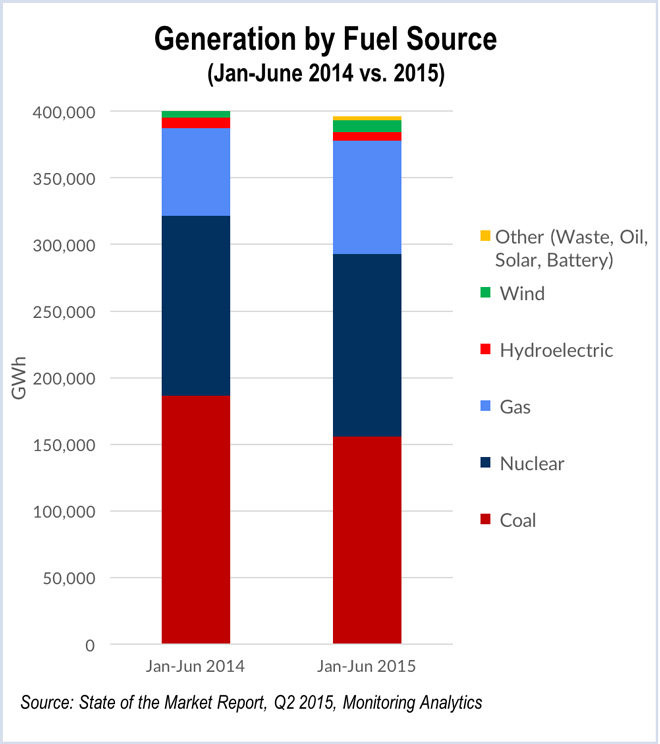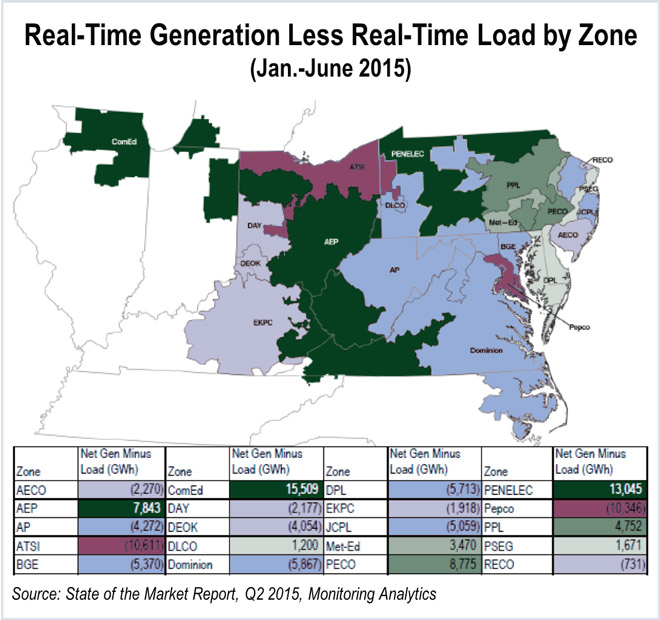By Rich Heidorn Jr.
PJM energy market prices were down almost 40% in the first half of 2015 compared with 2014, while capacity and transmission service charges rose by double digits, the Independent Market Monitor reported last week.
The load-weighted average real-time LMP, which hit $69.92/MWh in the first six months of 2014 — largely due to the record-breaking polar vortex in January — dropped to $42.30/MWh in 2015, the Monitor reported in its second-quarter State of the Market report.
Uplift charges dropped by $590.1 million (71%) in the first six months of 2015, while congestion costs were down $523.6 million (36%).
Auction revenue rights and financial transmission rights revenues offset 88% of congestion costs in the day-ahead energy market and the balancing energy market for the 2014/15 planning period.
Including capacity, transmission and other charges, prices were down almost 31%, from $88.90/MWh in 2014 to $61.61/MWh this year.
Withholding Concerns
The Monitor said prices reflected short-run marginal costs except during high demand hours in February 2015, which “raises concerns about economic withholding,” it said. The Monitor reported similar concerns for January 2014.
“Overall the market structure of the PJM aggregate energy market remains reasonably competitive for most hours, although the market structure during high demand hours remains a concern,” the report said.

“In particular, there are issues related to the ability to increase markups substantially in tight market conditions, to the uncertainties about the pricing and availability of natural gas, and to the lack of adequate incentives for unit owners to take all necessary actions to acquire fuel and generate power rather than take an outage.”
Net revenues were lower for all new entrant generation in the first six months of 2015 than in 2014. But net revenues for new entrant gas and coal units were generally higher in 2015 than in the first six months of every other year since 2009.
Coal Loses Generation Share; Solar up 30%
The RTO saw gas displacing coal, with coal-fired generation down 16% (to 39% of the total) and gas-fired generation up 29% (21% of the total). Solar net metering generation rose 30% to 262 GWh but remained only a flicker of the total (0.07%).
Recommendations
The report includes four new recommendations:
- Energy Market: PJM should remove non-specific fuel types such as “other” or “co-fire other” from the list of fuel types associated with their price and cost schedules. The Monitor recommends that PJM require market participants to make available at least one cost schedule with the same fuel type and parameters as that of their offered price schedule. (Priority: Medium)
- Demand Response: DR resources should be required to notify PJM of material changes affecting the capability of the resource to perform as registered. (Priority: Medium)
- Ancillary Services: PJM should report the reason for every hour in which PJM dispatch increases day-ahead synchronized reserve megawatts. (Priority: Medium)
- Planning: PJM should enhance the transparency and queue management process for merchant transmission investment to remove barriers to competition. (Priority: Medium). (See related story, PJM Monitor Asks FERC to Resolve TransSource Dispute.)




